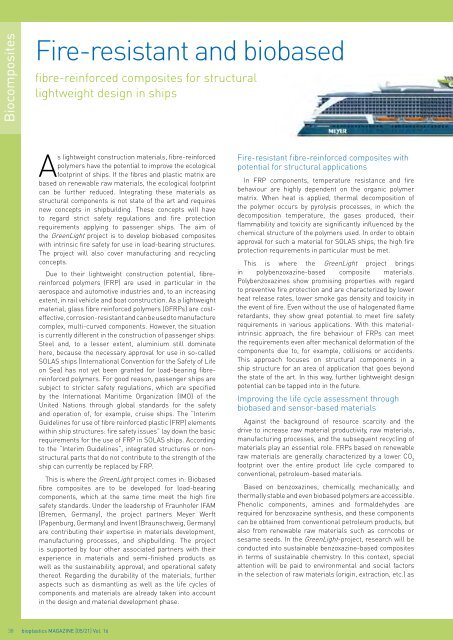issue 05/2021
Highlights: Fibres, Textiles, Nonwovens Biocomposites Basics: CO2-based plastics
Highlights:
Fibres, Textiles, Nonwovens
Biocomposites
Basics: CO2-based plastics
You also want an ePaper? Increase the reach of your titles
YUMPU automatically turns print PDFs into web optimized ePapers that Google loves.
Biocomposites<br />
Fire-resistant and biobased<br />
fibre-reinforced composites for structural<br />
lightweight design in ships<br />
As lightweight construction materials, fibre-reinforced<br />
polymers have the potential to improve the ecological<br />
footprint of ships. If the fibres and plastic matrix are<br />
based on renewable raw materials, the ecological footprint<br />
can be further reduced. Integrating these materials as<br />
structural components is not state of the art and requires<br />
new concepts in shipbuilding. These concepts will have<br />
to regard strict safety regulations and fire protection<br />
requirements applying to passenger ships. The aim of<br />
the GreenLight project is to develop biobased composites<br />
with intrinsic fire safety for use in load-bearing structures.<br />
The project will also cover manufacturing and recycling<br />
concepts.<br />
Due to their lightweight construction potential, fibrereinforced<br />
polymers (FRP) are used in particular in the<br />
aerospace and automotive industries and, to an increasing<br />
extent, in rail vehicle and boat construction. As a lightweight<br />
material, glass fibre reinforced polymers (GFRPs) are costeffective,<br />
corrosion-resistant and can be used to manufacture<br />
complex, multi-curved components. However, the situation<br />
is currently different in the construction of passenger ships:<br />
Steel and, to a lesser extent, aluminium still dominate<br />
here, because the necessary approval for use in so-called<br />
SOLAS ships (International Convention for the Safety of Life<br />
on Sea) has not yet been granted for load-bearing fibrereinforced<br />
polymers. For good reason, passenger ships are<br />
subject to stricter safety regulations, which are specified<br />
by the International Maritime Organization (IMO) of the<br />
United Nations through global standards for the safety<br />
and operation of, for example, cruise ships. The “Interim<br />
Guidelines for use of fibre reinforced plastic (FRP) elements<br />
within ship structures: fire safety <strong>issue</strong>s” lay down the basic<br />
requirements for the use of FRP in SOLAS ships. According<br />
to the “Interim Guidelines”, integrated structures or nonstructural<br />
parts that do not contribute to the strength of the<br />
ship can currently be replaced by FRP.<br />
This is where the GreenLight project comes in: Biobased<br />
fibre composites are to be developed for load-bearing<br />
components, which at the same time meet the high fire<br />
safety standards. Under the leadership of Fraunhofer IFAM<br />
(Bremen, Germany), the project partners Meyer Werft<br />
(Papenburg, Germany) and Invent (Braunschweig, Germany)<br />
are contributing their expertise in materials development,<br />
manufacturing processes, and shipbuilding. The project<br />
is supported by four other associated partners with their<br />
experience in materials and semi-finished products as<br />
well as the sustainability, approval, and operational safety<br />
thereof. Regarding the durability of the materials, further<br />
aspects such as dismantling as well as the life cycles of<br />
components and materials are already taken into account<br />
in the design and material development phase.<br />
Fire-resistant fibre-reinforced composites with<br />
potential for structural applications<br />
In FRP components, temperature resistance and fire<br />
behaviour are highly dependent on the organic polymer<br />
matrix. When heat is applied, thermal decomposition of<br />
the polymer occurs by pyrolysis processes, in which the<br />
decomposition temperature, the gases produced, their<br />
flammability and toxicity are significantly influenced by the<br />
chemical structure of the polymers used. In order to obtain<br />
approval for such a material for SOLAS ships, the high fire<br />
protection requirements in particular must be met.<br />
This is where the GreenLight project brings<br />
in polybenzoxazine-based composite materials.<br />
Polybenzoxazines show promising properties with regard<br />
to preventive fire protection and are characterized by lower<br />
heat release rates, lower smoke gas density and toxicity in<br />
the event of fire. Even without the use of halogenated flame<br />
retardants, they show great potential to meet fire safety<br />
requirements in various applications. With this materialintrinsic<br />
approach, the fire behaviour of FRPs can meet<br />
the requirements even after mechanical deformation of the<br />
components due to, for example, collisions or accidents.<br />
This approach focuses on structural components in a<br />
ship structure for an area of application that goes beyond<br />
the state of the art. In this way, further lightweight design<br />
potential can be tapped into in the future.<br />
Improving the life cycle assessment through<br />
biobased and sensor-based materials<br />
Against the background of resource scarcity and the<br />
drive to increase raw material productivity, raw materials,<br />
manufacturing processes, and the subsequent recycling of<br />
materials play an essential role. FRPs based on renewable<br />
raw materials are generally characterized by a lower CO 2<br />
footprint over the entire product life cycle compared to<br />
conventional, petroleum-based materials.<br />
Based on benzoxazines, chemically, mechanically, and<br />
thermally stable and even biobased polymers are accessible.<br />
Phenolic components, amines and formaldehydes are<br />
required for benzoxazine synthesis, and these components<br />
can be obtained from conventional petroleum products, but<br />
also from renewable raw materials such as corncobs or<br />
sesame seeds. In the GreenLight-project, research will be<br />
conducted into sustainable benzoxazine-based composites<br />
in terms of sustainable chemistry. In this context, special<br />
attention will be paid to environmental and social factors<br />
in the selection of raw materials (origin, extraction, etc.) as<br />
38 bioplastics MAGAZINE [<strong>05</strong>/21] Vol. 16

















